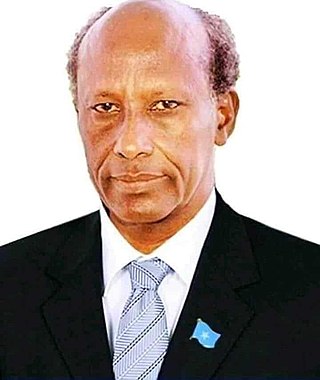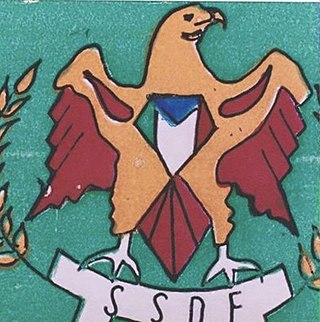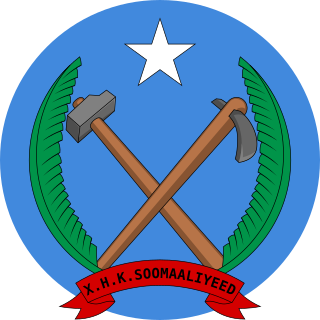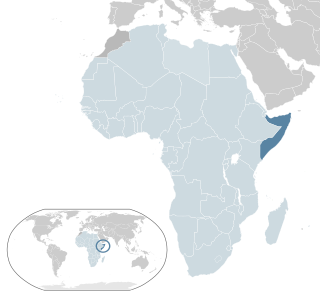Related Research Articles

Mohamed Farrah Hassan Aidid was a Somali general and diplomat.

Mohamed Siad Barre was a Somali head of state and general who served as the 3rd president of the Somali Democratic Republic from 1969 to 1991. He was given the childhood nickname Barre roughly referring to extraversion. Barre, a major general of the gendarmerie by profession, became President of Somalia after the 1969 coup d'état that overthrew the Somali Republic following the assassination of President Abdirashid Shermarke. The Supreme Revolutionary Council military junta under Barre reconstituted Somalia as a one-party Marxist–Leninist communist state, renamed the country the Somali Democratic Republic and adopted scientific socialism.

The Somali Democratic Republic was the name that the socialist military government gave to Somalia under President Major General Mohamed Siad Barre, after seizing power in a coup d'état on 21 October 1969. The coup came a few days after a bodyguard assassinated Abdirashid Shermarke, the nation's second President. Barre's administration ruled Somalia for the next 21 years until Somalia collapsed into civil war in 1991.

Somali Salvation Democratic Front (SSDF) (Somali: Jabhadda Diimuqraadiga Badbaadinta Soomaaliyeed), initially known as the Democratic Front for Salvation of Somalia, was a political and paramilitary umbrella organization in Somalia. Founded in 1978 by several army officers, it was the first of several opposition groups dedicated to ousting the authoritarian regime of Mohamed Siad Barre. With its power base mainly in the Majeerteen clan, SSDF representatives, along with local elders, intellectuals and business people, were instrumental in the establishment in 1998 of the autonomous Puntland state in northeastern Somalia.

The Somali Revolutionary Socialist Party was the ruling party of the Somali Democratic Republic from 1976 to 1991.
The Marehan is a Somali clan, which is part of one of the largest Somali clans families, the Darod. The clan is one of the largest constituent sub-clans of the Darod. The majority of the Marehan live in the Jubaland in southern Somalia, as well as the Galguduud and Mudug regions in central Somalia, the Somali region of Ethiopia and the North Eastern Province of Kenya.
Hirsi Magan Isse, commonly known as Hirsi Magan, was a scholar and a leading figure of the Somali revolution. Part of Somalia's political elite, he was a leader in the Somali Salvation Democratic Front (SSDF), one of the earliest and most influential factions in the Somali Civil War that broke out in 1991.
SRSP may refer to:
Following the civil war and the ensuing societal chaos, some factions managed to exert a degree of authority over certain regions of Somalia where they maintained broad, clan-based support. This allowed these factions to establish working administrations and eventually coherent states, and restored order to their regions. This occurred first in Puntland, Southwestern Somalia, Galmudug, Jubaland and finally Banadir.
The Somali Rebellion was the beginning of the civil war in Somalia that occurred in the 1980s and early 1990s. The rebellion started in 1978 when President Siad Barre began using his special forces, the "Red Berets", to attack clan-based dissident groups opposed to his regime. The dissidents had been becoming more powerful for nearly a decade following his abrupt switch of allegiance from the Soviet Union to the United States and the disastrous 1977-78 Ogaden War.

The National Security Service (NSS) was the primary intelligence agency of the Somali Democratic Republic from 1970 to 1990. The NSS was formed as under government of Siad Barre in 1970, modelled after the KGB of the Soviet Union, and was formally dissolved in 1990 shortly before Barre's overthrow. In 2013, the Federal Government of Somalia re-established the NSS as the national intelligence service, renaming it the National Intelligence and Security Agency (NISA).
The Somali National Front (SNF) was a politico-military organization that operated in southern Somalia during the Somali Civil War and represented one of the major factions involved in the conflict.
Over the course of the Somali Civil War, there have been many revolutionary movements and militia groups run by competing rebel leaders which have held de facto control over vast areas within Somalia.
The 1982 Ethiopian–Somali Border War occurred between June and August 1982 when Ethiopia, sending a 100,000 man invasion force backed by warplanes and armored units, supported by thousands of SSDF rebels invaded Central Somalia. The United States government responded by speeding up deliveries of light arms and main battle tanks already promised. In addition, the initially pledged US$45 million in economic and military aid was increased to US$80 million.

Parliamentary elections were held in Somalia on 30 December 1979. The elections were the first since 1969 and the first to be held under the new constitution approved in a referendum held in August, which had made the country a one-party state. As a result, the Somali Revolutionary Socialist Party (SRSP) was the only party to participate in the election, with voters being asked to vote yes or no to a single list of 171 candidates. A reported 99.95% of voters ultimately approved the list. The Assembly elected Siad Barre as President, who then nominated a further six members to the Assembly.

Presidential elections were held in Somalia on 23 December 1986, the first time a direct election for President had been held. The country was a one-party state at the time, with the Somali Revolutionary Socialist Party (SRSP) as the sole legal political party. Its leader, incumbent President Siad Barre, was the only candidate. He was re-elected with fewer than 1,500 votes against his candidacy.

The Supreme Revolutionary Council was the governmental body that ruled Somalia from 1969 to 1976.

The 1969 Somali coup d'état was the bloodless takeover of Somalia's government on 21 October 1969 by military officers of the Supreme Revolutionary Council led by Siad Barre. Somali troops supported by tanks under the command of Barre stormed Mogadishu and seized key government buildings and ordered the resignation of the country's leaders. The coup deposed President Sheikh Mukhtar Mohamed Hussein and Prime Minister Mohammad Egal and led to the twenty-one year long military rule by Barre and the imposition of an authoritarian government in Somalia until 1991.

The 1978 Somali coup d'état attempt was a violent military coup attempt that took place in Somalia on 9 April 1978, against the regime of President Siad Barre. The United States Central Intelligence Agency estimated that the coup, led by Colonel Mohamed Osman Irro, involved around 24 officers, 2,000 soldiers, and 65 tanks. Following the failed coup, 17 alleged ringleaders, including Osman, were summarily executed by firing squad.
The Somali Democratic Action Front is the first political faction of the Somali Rebellion.
References
- ↑ Internationales Afrika Forum , Vol. 17–18. Europäisches Institut für Politische, Wirtschaftliche und Soziale Fragen, 1981. p. 47
- 1 2 3 4 Nelson, Harold D. Somalia, a Country Study . [Whitefish, Mont.]: Kessinger Publishing, 2004. p. 222
- ↑ Krech, Hans. Der Bürgerkrieg in Somalia (1988-1996): ein Handbuch . Berlin: Verlag Dr. Köster, 1996. p. 221
- ↑ Henriques, John L. Syria: Issues and Historical Background . [Hauppauge], N.Y.: Nova Science Publishers, 2003. p. 214